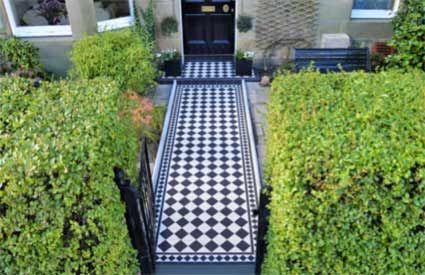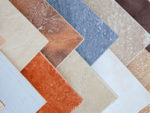This section is dedicated to ceramic tiles and tiling with ceramic tiles, rather than all the other types of tiles that are available. It is generally considered that tiling with ceramic tiles can be a little more difficult due to their hardness and finish which can be damaged if you are not careful. We cover how you can cut and lay tiles yourself, with tips and tricks from the pros to make the project easier.
Below we explain what ceramic tiles are, and how they differ from porcelain tiles, which they are often confused with.
There is also help on choosing ceramic tiles in this section, however if you are looking for information about all other types of tiles we have a section on Non Ceramic Tiles and Tiling where you will find more information.
To finish your tiling project you will need information on grout and grouting, whether you are using ceramic tiles or not. You will be able to find projects and all the guidance you need in our Grout and Grouting section.

What are Ceramic Tiles?
There is a relatively good definition of “a tile” on Wikipeda, which we will use:
a manufactured piece of hard-wearing material such as ceramic, stone, metal, or even glass, generally used for covering roofs, floors, walls, showers, or other objects such as tabletops.
No surprises here, but what is a ceramic tile and why the fuss about them?
Ceramic tiles are tiles that have been shaped, pressed and fired. A mixture of clays and minerals are used and then fired to a very high temperature – typically 1000°C and above. Ceramic tiles are actually a “family” of tile types which can be confusing as this definition can include “porcelain” and ‘ceramic’ tiles.
It is probably best to think of them as a spectrum along which the quality, density and permeability varies. At the top end are porcelain tiles which is a term usually restricted (but frustratingly not always, especially when you’re talking to an overzealous salesman) to tiles which have been vitrified or nearly melted before setting to form a glassy texture. This is as opposed to being covered in a glaze which melts to form a glossy surface and holds the colour as in ceramic tiles.

The rest are typically referred to as “ceramic” although these can be further divided along this spectrum, from earthenware at the least durable and softest end to stoneware before reaching the porcelain tiles.
Exact definitions are hard to pin down and when you add a layer of sales speak on top if can be very confusing, so it is worth taking some time to work out what you need.
In summary, the term “ceramic tiles” generally refers to any tiles that have been fired in a kiln, either glazed or unglazed. So what’s the difference between Porcelain and (the rest of the) Ceramic Tiles?
The Difference between Porcelain and Ceramic Tiles
Porcelain ties are made from higher quality porcelain clay, and will be denser and less permeable. They will always be more expensive, which is why the definition is so flexible, with many tiles being described as porcelain when their claim to the description is equivocal.

The term porcelain is derived from the Italian word “porcellana” which means cowry shell. A porcelain tile will have the feel and texture as a shell or fine china which is made in a similar way and with the same ingredients.
There are two types of tile that is described as porcelain; the first as undisputedly porcelain by every definition and are closer to vitrified tiles as the colour of the tile is present right through the tile, rather like a stick of rock. This means that they wear very well and cannot fade or have the patterns chipped off.
The second type of porcelain tile is one where the colour and pattern is held in the glaze. This is the shiny surface of the tile which is formed when the tile is fired.

This second type of porcelain tile is very similar to what we think of as ceramic tiles, or non-porcelain tiles. They are typically made lower quality clays, generally red of white clays, which are coated with a glaze and then fired. The glaze holds the colour and pattern in a durable and hard wearing surface layer. The glaze is vitrified during firing which allows it to form a hard surface when it cools.
The non-porcelain type of tiles will always be softer and therefore easier to cut than actual porcelain tiles. The glaze can get chipped which will expose the red of white clay below which will be unsightly.
Some ceramic tiles will not have a glaze; they will have been fired without applying a glaze. Quarry or terracotta tiles are types of unglazed tiles. These tiles are porous and therefore need to be sealed to stop them becoming stained or absorbing water.
Types of Ceramic Tiles
As you can already see the term ceramic tiles includes a wide range of types of tiles depending on how and who is using it. The main types of ceramic tiles include:
- Porcelain: As we have discussed above these are the most dense and impermeable tiles of the ceramic tile family
- Stoneware: These are less dense and slightly more permeable than porcelain tiles, but they will be fired with a glaze so that they are decorative and smooth. They are similar in material and style to table ware which is made in the same way
- Earthenware: This is the softest and most permeable of the ceramic tiles. The material used to make them is the same as potters would use. The tiles can be glazed or not, such as quarry or terracotta tiles
Glazes can be used on all types of tiles, and it is designed to apply the colour and pattern as well as to provide a protective coating to the tile surface. This makes the tile easier to clean, more durable and resistant to stains.
The glaze is applied before firing and it will vitrify during the firing process and will then cool to a hard, shiny surface. A glaze can be chipped or cracked if struck.

In summary, we have a spectrum of ceramic tiles where porcelain tiles are at the top for every measure:
- Density
- Difficulty of cutting
- Non-permeability
- Cost
- Durability
In the USA, we understand, that there are specific guidelines about the permeability of a tile and if it is over a particularly threshold then the tile is allowed to be described as “porcelain”
Benefits of Ceramic and Porcelain Tiles
There are a number of features of ceramic tiles that makes them ideal for using in our homes. As you travel up the spectrum towards porcelain these features become more pronounced and therefore the benefits improve, however so does the cost.
Here are the key benefits of using porcelain or ceramic tiles:
- Water Resistance – or non-permeability. Glazed ceramic tiles are in effect completely water proof. (They will absorb water but as such a slow rate that it will not penetrate beyond the tile.) This makes them a very useful method of protecting bathroom and kitchen walls and floors, or anywhere else that is likely to get wet
- Durability – They are hard wearing and there can be used in areas of high traffic with the confidence that they will outlast you! They are resistant to scratches and heat
- Decoration – Ceramic tiles can be highly decorative in their own right or they can be laid in decorative patterns, particularly when mosaic tiles are used. The colours will be permanent and not fade in sunlight or as a result of heavy traffic
- Hygienic – A glazed ceramic tile has a smooth nonporous surface which means that it can be cleaned very easily, making it hygienic. This is ideal for kitchens and bathrooms
- Variation and easy of manufacture – they are easy to make; we have been making them since before Roman times. This means that there are endless variations and variety; your imagination is the only limit to your design!
Where to Use Ceramic and Porcelain Tiles
Both ceramic and porcelain tiles have traditionally been used for floor and wall tiles. However they have not been considered suitable for external use, particularly porcelain tiles.
Because they are durable and resistant to scratching they are able to be used in areas of high traffic where other surfaces can get worn away quickly. This makes them ideal for hall ways floor tiles or counter top tiles.
They are heat and water resistant which makes them ideal for kitchen surfaces and splashbacks. They are also water resistant which means that they are ideal for bathrooms and anywhere that will get wet.
When it comes to using them outside there are now certain ceramic tiles that are suitable, but make sure that you confirm this before laying them. Ceramic tiles, even porcelain tiles, are not completely water proof but they are very hard and rigid. When the water gets into the tile it freezes and expands which will crack the tiles – not something you want to happen with expensive porcelain tiles! You can find out more about Freeze Thaw action here.

When choosing your tiles it is important to get higher quality and more durable tiles where the traffic and therefore wear is going to be more pronounced. Porcelain tiles will be better where you need to have a water resistant surface. If you are going to use ceramic tiles outside, ensure that they are suitable for the purpose before making a potentially costly mistake.
It is worth considering that softer tiles are easier to cut, so if you’re doing the project yourself you might want to focus on areas that don’t need very hard (and expensive) porcelain tiles, or perhaps do the areas that need harder (more expensive) porcelain times later in the job once you’re more practiced.





